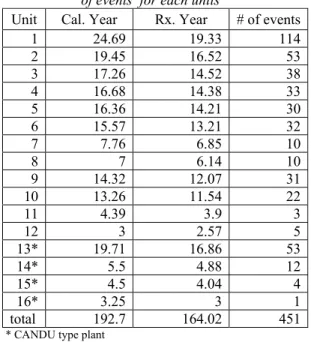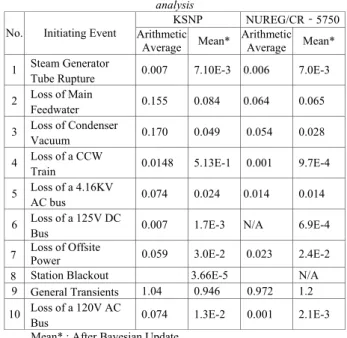Study on the Transient Event Experiences for Nuclear Power Plants in Korea
Park, Jin-Hee, Han, Sang-Hoon, Kilyoo Kim P.O. Box 105, Yusong, Taejon, 305-600, Korea Tel : +82(42)868-8297, Fax: +82(42)868-8256
Email:jhpark6@kaeri.re.kr
I. INTRODUCTION
It is recognized that operating experience data is essential for an accident analysis (including Probabilistic Safety Assessment) and other quantitative activities such as a Risk or Performance informed application for a nuclear power plant. The data for a PSA or other quantitative activities have to use specific data with respected to the domestic operation characteristic, because they are considered important contributors to the total risk at a nuclear power plant.
The main purpose of this study is to develop transient initiating event frequencies from Korean domestic operational data to utilize them in a PSA or Risk(or performance) informed application. For the objectives, Korean specific nuclear power plants transient data gathering and the development of an analysis program are performed to identify and analysis the data sources and summarize the information they contain in ways useful for a probabilistic safety assessment and other quantitative activities.
II. Data gathering and Database program development For this study, unplanned plant transient data has been gathered from all the commercial nuclear power plants in Korea during April 1978 in which the first nuclear power plant started its commercial operation through the end of 2002. During this duration, about 451 plant transient events were gathered from 16 commercial operating nuclear power plants and the cumulative operating experience has been about 164 reactor operating years. After the data were collected each transient was reviewed and categorized to apply it to a PSA or other quantitative activities. Table 1 summarizes operating year and the number of unplanned transient events collected from each plant.
In order to analyze the data, the computer-based database program was developed to display information from the data collected. After the data was collected and inserted into to the database program, each transient was reviewed and analyzed.
III. Analysis.
Transient initiating event frequencies are an essential input to the analysis process of a nuclear power plant PSA or quantitative activities. To evaluate the initiating event frequencies, all the events except for the events which occurred in CANDU Type plants(4 plants are CANDU type in Korea) are inserted into the computer program according to the EPRI PWR transient category.
Table 1. Summary on the operating year & number of events for each units
Unit Cal. Year Rx. Year # of events
1 24.69 19.33 114 2 19.45 16.52 53 3 17.26 14.52 38 4 16.68 14.38 33 5 16.36 14.21 30 6 15.57 13.21 32 7 7.76 6.85 10 8 7 6.14 10 9 14.32 12.07 31 10 13.26 11.54 22 11 4.39 3.9 3 12 3 2.57 5 13* 19.71 16.86 53 14* 5.5 4.88 12 15* 4.5 4.04 4 16* 3.25 3 1 total 192.7 164.02 451
* CANDU type plant
The EPRI PWR category #35 subdivided into five subsets could be applied to a PSA directly and a steam generator tube rupture event is added in the EPRI PWR category # 26. Table 3 summarizes the result of the EPRI Category classification.
In this study, the initiating events frequencies for 9 transient events and 1 steam generator tube rupture events were evaluated because these events has been experienced in Korea and they could be reflected in the domestic operating experience. The results were also compared with the U.S recent initiating transient frequencies and the results of this evaluation are summarized in Table 4.
Transactions of the Korean Nuclear Society Autumn Meeting Busan, Korea, October 27-28, 2005
Table 3. The results of the EPRI PWR Transient category classification
EPRI Category # of event EPRI 1 Loss of RCS Flow (1 Loop) 5 EPRI 2 Uncontrolled Rod Withdrawal 0 EPRI 3 CRDM Problems and/or Rod Drop 38 EPRI 4 Leakage from Control Rods 1 EPRI 5 Leakage in Primary System 11 EPRI 6 Low Pressurizer Pressure 1 EPRI 7 Pressurizer Leakage 1 EPRI 8 High Pressurizer Pressure 0 EPRI 9 Inadvertent Safety Injection Signal 2 EPRI 10 Containment Pressure Problems 0 EPRI 11 CVCS Malfunction – Boron Dilution 0 EPRI 12
Pressure/Temperature/Power Imbalance - Rod
Position Error 1
EPRI 13 Startup of Inactive Coolant Pump 0 EPRI 14 Total Loss of RCS Flow 4 EPRI 15 Loss or Reduction in Feedwater Flow (1 loop) 43 EPRI 16 Total Loss of Feedwater Flow (all loops) 11 EPRI 17 Full or Partial Closure of MSIV (1 loop) 11 EPRI 18 Closure of All MSIV 6 EPRI 19 Increase in Feedwater Flow (1 Loop) 9 EPRI 20 Increase in Feedwater Flow (All Loop) 0 EPRI 21 Feedwater Flow Instability-Operator Error 5 EPRI 22
Feedwater Flow Instability-Miscellaneous
Mechanical Causes 4
EPRI 23 Loss of Condensate Pumps (1 Loop) 0 EPRI 24 Loss of Condensate Pumps (All Loops) 0 EPRI 25 Loss of Condenser Vacuum 6 EPRI 26 Steam Generator Leakage - Steam Generator Tube Rupture : 1 5
EPRI 27 Condenser Leakage 2
EPRI 28 Miscellaneous Leakage in Secondary System 7 EPRI 29 Sudden Opening of Steam Relief Valves 0 EPRI 30 Loss of Circulating Water 15 EPRI 31 Loss of Component Cooling 2 EPRI 32 Loss of Service Water System 0 EPRI 33
Turbine Trip, Throttle Valve Closure, EHC
Problems 47 EPRI 34 Generator Trip or Generator Caused Faults 51
EPRI 35 Loss of All Offsite Power 8 EPRI 36 Pressurizer Spray Failure 0
EPRI 37
Loss of Power to Necessary Plant Systems -Loss of 13.8KV power: 12 -Loss of 4.16kV power: 10 -Loss of 125V DC power: 1 -Loss of 120V AC power: 10 -Loss of 480V AC power: 3 36
EPRI 38 Spurious Trips-Cause Unknown 0 EPRI 39 Automatic Trip-No Transient Condition 20 EPRI 40 Manual Trip-No Transient Condition 11
EPRI 41 Fire Within Plant 2
Most of the initiating event cases, for an arithmetic average of the Korean specific data is higher than that of the U.S experience because the Korean operating experience is too short when compare to the U.S operating experience during the Bayesian updating process.
IV. CONCLUSIONS
In this study, unplanned plant transient are gathered and analyzed. An initiating event frequencies evaluation were performed to obtain an insight from the Korean domestic data.
Table 4. The result of the preliminary initiating events frequency analysis
KSNP NUREG/CR‐5750 No. Initiating Event Arithmetic
Average Mean*
Arithmetic Average Mean* 1 Steam Generator
Tube Rupture 0.007 7.10E-3 0.006 7.0E-3 2 Loss of Main
Feedwater 0.155 0.084 0.064 0.065 3 Loss of Condenser
Vacuum 0.170 0.049 0.054 0.028
4 Loss of a CCW
Train 0.0148 5.13E-1 0.001 9.7E-4 5 Loss of a 4.16KV
AC bus 0.074 0.024 0.014 0.014 6 Loss of a 125V DC
Bus 0.007 1.7E-3 N/A 6.9E-4 7 Loss of Offsite Power 0.059 3.0E-2 0.023 2.4E-2 8 Station Blackout 3.66E-5 N/A
9 General Transients 1.04 0.946 0.972 1.2 10 Loss of a 120V AC
Bus 0.074 1.3E-2 0.001 2.1E-3 Mean* : After Bayesian Update
The preliminary Bayesian update with the Korean specific data and the U.S data did not not show a big difference, because the Korean operating experience is too short when compare to the U.S operating experience. The Korean specific transient database would of cause be updated yearly and the results of this study could be used as basic information for a probabilistic risk assessment and other quantitative activities in Korea.
ACKNOWLEDGMENTS
This work has been carried out under the Nuclear long term R&D Program sponsored by the Korea Ministry of Science and Technology.
REFERENCES
1. Development of a database system for shutdown events of nuclear power plants in Korea”, KAERI/TR-2131/2002, 2002.
2. Development of transient initiating event frequencies for use in Probabilistic Risk Assessments,
NUREG/CR-3862, 1985.
3. Updating of initiating events frequencies in the UCN 3,4 PSA”, KAERI/TR-2957/2005, 2005.
4. Rates of Initiating Events at U.S Nuclear Power Plants:1987 -1995, NUREG/CR-5750, 2002.

